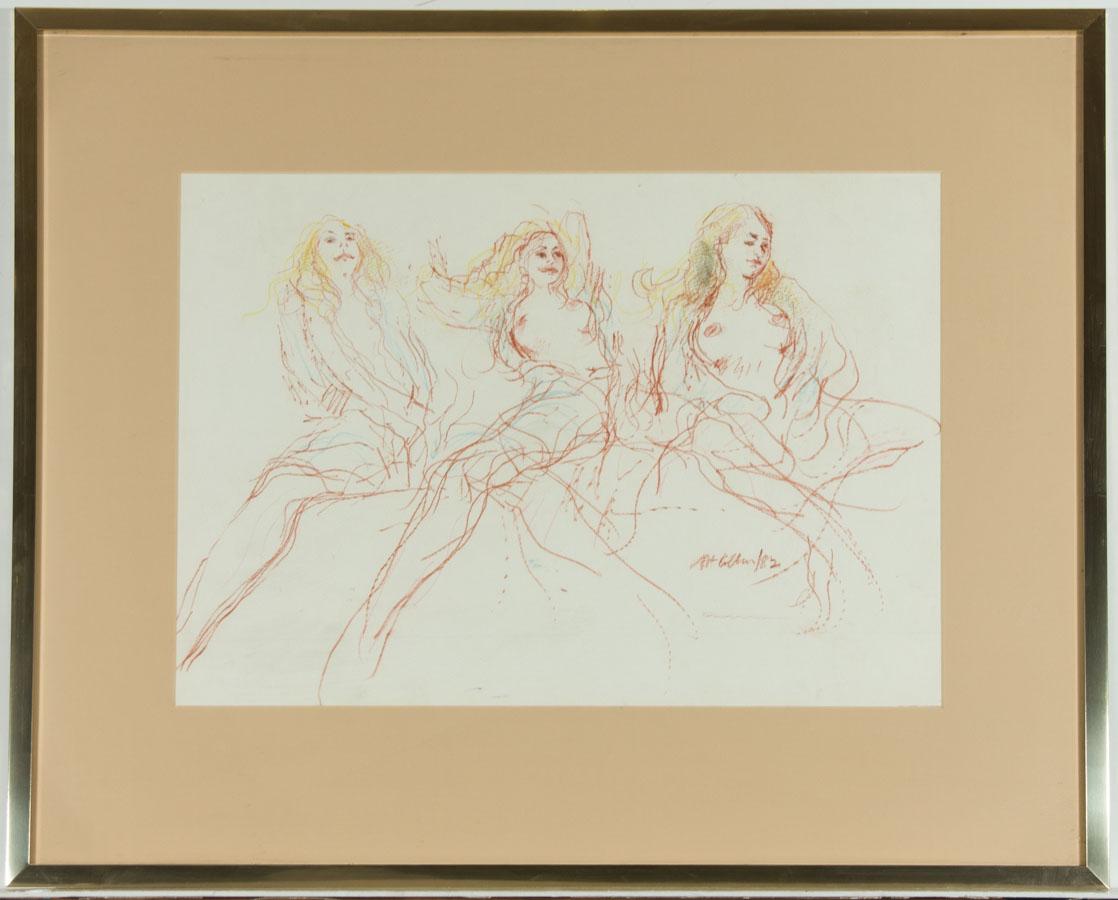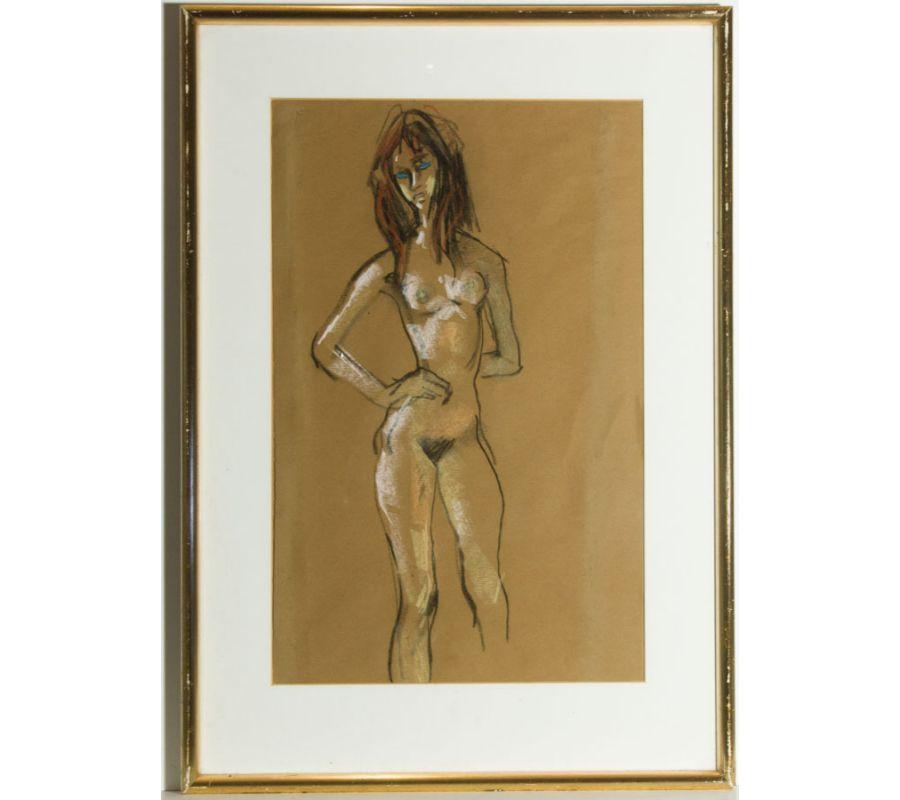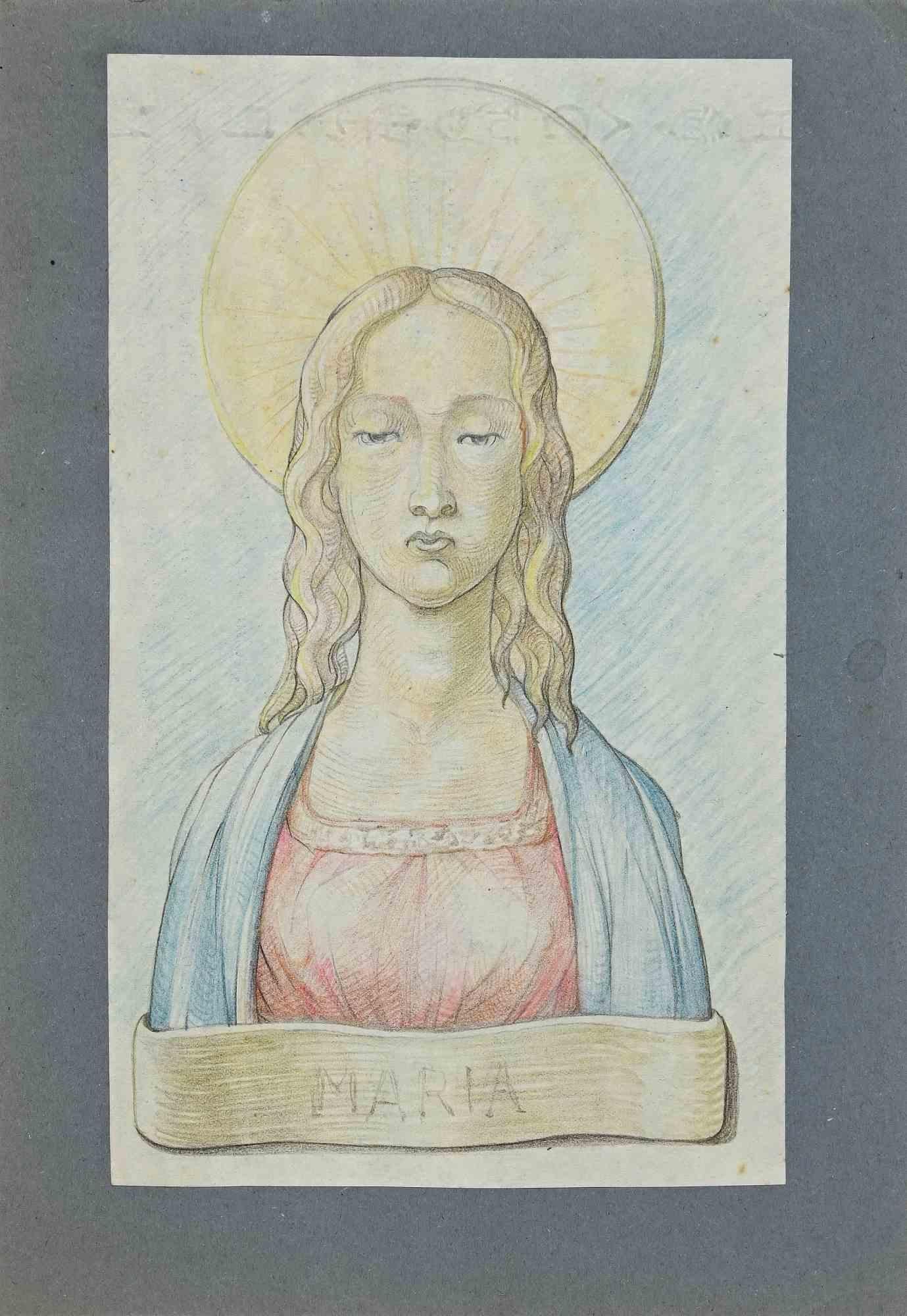Peter Collins ARCAPeter Collins ARCA - Signed and Framed 1980 Pastel, Self Portrait1980
1980
About the Item
- Creator:Peter Collins ARCA (1923 - 2001, British)
- Creation Year:1980
- Dimensions:Height: 20.08 in (51 cm)Width: 24.22 in (61.5 cm)
- Medium:
- Period:
- Condition:
- Gallery Location:Corsham, GB
- Reference Number:Seller: ke3031stDibs: LU881310139652
Peter Collins ARCA
With a fondness for life drawing, Peter Collins ARCA was perhaps a natural choice for the bikini-clad inhabitants of the pages of a holiday brochure. Collins's first job was at an advertising agency, in the commercial studio, while he attended evening art classes. World War II interrupted his career and he joined the Royal Artillery (of the British Army), teaching painting and drawing in the Education Corps, while simultaneously teaching at St Martin's School of Art, part time. Following the war, Collins studied at the Royal College of Art, winning a scholarship. Leaving in 1950, he then worked as a commercial artist producing some well-known posters for clients including British Railways and British European Airways. He was the Art Director at Odhams Press and spent time designing for both ICI and Shell. With his wife Georgette, he created the 'Bacombe Galleries' in Sussex, converting a group of buildings. In 1975, they again converted buildings, this time Stanley Studios in Chelsea, which were scheduled for redevelopment; many artists had worked there, probably the most famous being Elizabeth Frink. Combining an artist's studio and a single residence at Stanley Studios, the Collins’ were immersed in Chelsea's art scene and proceeded to fill the place with art, antiques, sculptures and curios.
- ShippingRetrieving quote...Ships From: Corsham, United Kingdom
- Return PolicyA return for this item may be initiated within 30 days of delivery.
- Joyce Moore - Signed Contemporary Pastel, Portrait of a Man in ThoughtLocated in Corsham, GBA vibrant palette is used in a gestural manner to depict a captivating portrait of a man deep in thought. The artwork holds a charismatic charm and is signed in the bottom right-hand...Category
21st Century and Contemporary Portrait Drawings and Watercolors
MaterialsPastel
- Donald Wood (1889-1953) - Framed 1932 Pastel, Innocent EyesLocated in Corsham, GBA fine head and shoulders portrait of an innocent young girl, delicately depicted in soft pastel by British artist Donald Wood (1889-1953). The drawing has...Category
Early 20th Century Portrait Drawings and Watercolors
MaterialsPastel
- Framed 19th Century Pastel - Victorian ChildLocated in Corsham, GBThis fine Victorian portrait depicts a rosy cheeked and red lipped girl, sat wearing a black buttoned down frock with delicate lace collar. The artist has man...Category
19th Century Portrait Drawings and Watercolors
MaterialsPastel
- Marjorie Cox (1915-2003) - Framed 1970 Pastel, Portrait of MistyBy Marjorie CoxLocated in Corsham, GBA fine pastel portrait of brown eyed Border Collie Misty, by the well-listed animal portraitist Marjorie Cox (1915-2003). Smartly mounted in a handsome gilt-effect frame with the art...Category
Mid-20th Century Portrait Drawings and Watercolors
MaterialsPastel
- Frederick William George (1889-1971) - Mid 20th Century Pastel, Flower ArrangingLocated in Corsham, GBA delightful pastel study of a woman arranging small spring flowers into a brightly coloured vase. The artist captures the scene in bright, uplifting colours from the neatly arranged...Category
Mid-20th Century Portrait Drawings and Watercolors
MaterialsPastel
- 20th Century Pastel - Regency BeautiesLocated in Corsham, GBA delightful pastel portrait depicting three Regency women in fashionable dress. The style is a of the French revival period of the early 20th Century, ...Category
21st Century and Contemporary Portrait Drawings and Watercolors
MaterialsPastel
- Rare Modernist Hungarian Rabbi Pastel Drawing Gouache Painting Judaica Art DecoBy Hugó ScheiberLocated in Surfside, FLRabbi in the synagogue at prayer wearing tallit and tefillin. Hugó Scheiber (born 29 September 1873 in Budapest – died there 7 March 1950) was a Hungarian modernist painter. Hugo Scheiber was brought from Budapest to Vienna at the age of eight where his father worked as a sign painter for the Prater Theater. At fifteen, he returned with his family to Budapest and began working during the day to help support them and attending painting classes at the School of Design in the evening, where Henrik Papp was one of his teachers. He completed his studies in 1900. His work was at first in a post-Impressionistic style but from 1910 onward showed his increasing interest in German Expressionism and Futurism. This made it of little interest to the conservative Hungarian art establishment. However, in 1915 he met the great Italian avant-gardist Filippo Tommaso Marinetti and the two painters became close friends. Marinetti invited him to join the Futurist Movement. The uniquely modernist style that he developed was, however, closer to German Expressionism than to Futurism and eventually drifted toward an international art deco manner similar to Erté's. In 1919, he and his friend Béla Kádar held an exhibition at the Hevesy Salon in Vienna. It was a great success and at last caused the Budapest Art Museum to acquire some of Scheiber's drawings. Encouraged, Scheiber came back to live in Vienna in 1920. A turning point in Scheiber's career came a year later, when Herwarth Walden, founder of Germany's leading avant-garde periodical, Der Sturm, and of the Sturm Gallery in Berlin, became interested in Scheiber's work. Scheiber moved to Berlin in 1922, and his paintings soon appeared regularly in Walden's magazine and elsewhere. Exhibitions of his work followed in London, Rome, La Paz, and New York. Scheiber's move to Germany coincided with a significant exodus of Hungarian artists to Berlin, including Laszlo Moholy-Nagy and Sandor Bortnyik. There had been a major split in ideology among the Hungarian avant-garde. The Constructivist and leader of the Hungarian avantgarde, Lajos Kassák (painted by Hugó Scheiber in 1930) believed that art should relate to all the needs of contemporary humankind. Thus he refused to compromise the purity of his style to reflect the demands of either the ruling class or socialists and communists. The other camp believed that an artist should be a figurehead for social and political change. The fall out and factions that resulted from this politicisation resulted in most of the Hungarian avant gardists leaving Vienna for Berlin. Hungarian émigrés made up one of the largest minority groups in the German capital and the influx of their painters had a significant effect on Hungarian and international art. Another turning point of Scheiber's career came in 1926, with the New York exhibition of the Société Anonyme, organized by Katherine Dreier. Scheiber and other important avant garde artists from more than twenty-three countries were represented. In 1933, Scheiber was invited by Marinetti to participate in the great meeting of the Futurists held in Rome in late April 1933, Mostra Nazionale d’Arte Futurista where he was received with great enthusiasm. Gradually, the Hungarian artists began to return home, particularly with the rise of Nazism in Germany. Kádar went back from Berlin in about 1932 and Scheiber followed in 1934. He was then at the peak of his powers and had a special flair in depicting café and cabaret life in vivid colors, sturdily abstracted forms and spontaneous brush strokes. Scheiber depicted cosmopolitan modern life using stylized shapes and expressive colors. His preferred subjects were cabaret and street scenes, jazz musicians, flappers, and a series of self-portraits (usually with a cigar). his principal media being gouache and oil. He was a member of the prestigious New Society of Artists (KUT—Képzőművészek Új Társasága)and seems to have weathered Hungary's post–World War II transition to state-communism without difficulty. He continued to be well regarded, eventually even receiving the posthumous honor of having one of his images used for a Russian Soviet postage stamp (see image above). Hugó Scheiber died in Budapest in 1950. Paintings by Hugó Scheiber form part of permanent museum collections in Budapest (Hungarian National Museum), Pecs (Jannus Pannonius Museum), Vienna, New York, Bern and elsewhere. His work has also been shown in many important exhibitions, including: "The Nell Walden Collection," Kunsthaus Zürich (1945) "Collection of the Société Anonyme," Yale University Art Gallery, New Haven, Connecticut (1950) "Hugó Scheiber: A Commemorative Exhibition," Hungarian National Museum, Budapest (1964) "Ungarische Avantgarde," Galleria del Levante, Munich (1971) "Paris-Berlin 1900-1930," Centre Georges Pompidou, Paris (1978) "L’Art en Hongrie, 1905-1920," Musée d’Art et l’Industrie, Saint-Etienne (1980) "Ungarische Avantgarde in der Weimarer Republik," Marburg (1986) "Modernizmus," Eresz & Maklary Gallery, Budapest (2006) "Hugó Scheiber & Béla Kádár," Galerie le Minotaure, Paris and Tel Aviv (2007) Hugó Scheiber's paintings continue to be regularly sold at Sotheby's, Christie's, Gillen's Arts (London), Papillon Gallery (Los Angeles) and other auction houses. He was included in the exhibition The Art Of Modern Hungary 1931 and other exhibitions along with Vilmos Novak Aba, Count Julius Batthyany, Pal Bor, Bela Buky, Denes Csanky, Istvan Csok, Bela Czobel, Peter Di Gabor, Bela Ivanyi Grunwald, Baron Ferenc Hatvany, Lipot Herman, Odon Marffy, C. Pal Molnar...Category
Early 20th Century Modern Figurative Paintings
MaterialsPaper, Charcoal, Pastel, Watercolor, Gouache
- Portrait of a Lady - Late 18th Century European PastelLocated in London, GBEuropean School Late 18th Century Portrait of a Lady Pastel on paper, mounted on canvas Image size: 28 x 23 inches Contemporary style frame Provenance: Ernst Museum Auction This pastel portrait of a lady dates from the late eighteenth century. She is pictured in a white muslin dress...Category
Late 18th Century Portrait Drawings and Watercolors
MaterialsLaid Paper, Pastel
- Portrait of a young woman, 19th Century PastelLocated in London, GBJohn Raphael Smith 1751 - 1812 Portrait of a young lady Pastel on paper on canvas stretcher Image size: 9 x 7 inches (23 x 18 cm) FramedCategory
Early 1800s Portrait Drawings and Watercolors
MaterialsPastel
- Pair of 19th century English chalk drawing on paper of CockerelBy William HugginsLocated in Woodbury, CTWilliam Huggins was born in Liverpool, England on the 13th of May, 1820. His parents were Samuel and Elisabeth Huggins. He took his first drawing lessons from the Liverpool Mechanics...Category
1870s Victorian Animal Drawings and Watercolors
MaterialsPaper, Pastel
- Portrait of a Young Girl, Mid-20th Century Pastel Drawing, SignedBy Alan DurmanLocated in London, GBPastel on paper, signed bottom right Image size: 12 x 14 1/2 inches (30.5 x 36.75 cm) Contemporary style hand made frame This is a touching drawing of a young girl who is seen smili...Category
Mid-20th Century Portrait Drawings and Watercolors
MaterialsPastel, Paper
- 'Portrait of a Young Man' — 1960s American ImpressionismBy Robert PhilippLocated in Myrtle Beach, SCRobert Philipp, 'Portrait of a Young Man', color pastel and wet brush, c. 1967. Signed in pencil, lower right. A fine, painterly drawing, on cream laid Michallet drawing paper. The artist's tack holes in the four sheet corners, in very good condition. Image size 19 x 11 1/2 inches (483 x 292 mm); sheet size 19 x 12 3/8 inches (483 x 314 mm). Archivally matted to museum standards, unframed. Provenance: Art Students League, from the artist’s personal portfolio. ABOUT THE ARTIST Robert Philipp (1895–1981) was a celebrated American Post-Impressionist painter known for his nudes, still lifes, and portraits. Noted art critic Henry McBride named Philipp one of America's top six painters of his generation. Philipp was an instructor of painting at the Art Students League, New York, for 33 years. Philipp was Secretary of the National Academy of Design, a National Academician, and a Benjamin Franklin Fellow at the Royal Society of Arts in London. His composition and painting style has been compared to the art of Edgar Degas and Pierre Auguste Renoir. In 1940, Philipp was invited to Los Angeles by Hollywood producer Louis B. Mayer to paint portraits of Metro-Goldwyn-Mayer movie stars. The same year, Walter Wanger, producer of ‘The Long Voyage Home’, directed by John Ford and based on plays by Eugene O'Neill, contracted with Reeves Lewenthal, head of the Associated American Artists gallery in Manhattan, to bring nine well-known artists to the set and paint scenes from the movie and portraits of the actors in character. The artists included Robert Philipp, Thomas Hart Benton, Grant Wood, Ernest Fiene, George Schreiber, Luis...Category
1940s American Impressionist Portrait Drawings and Watercolors
MaterialsPastel






